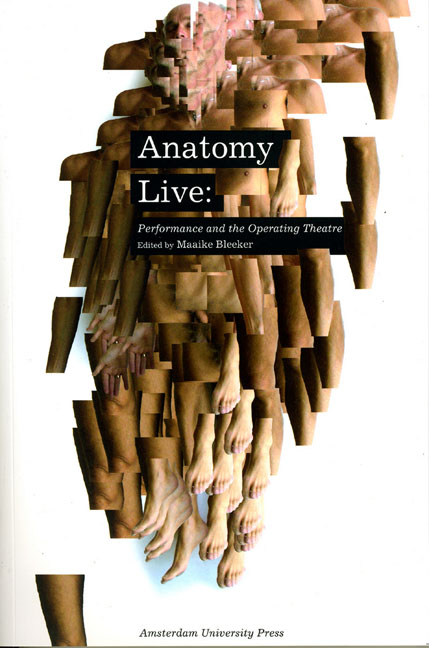Book contents
- Frontmatter
- Contents
- Acknowledgements
- Prologue - Men with Glass Bodies
- Introduction
- Performance Documentation 1: Holoman; Digital Cadaver
- Digital Cadavers and Virtual Dissection
- ‘Who Were You?’: The Visible and the Visceral
- Performance Documentation 2: Excavations: Fresh but Rotten
- The Anatomy Lesson of Professor Moxham
- ‘Be not Faithless But Believing’: Illusion and Doubt in the Anatomy Theatre
- Performance Documentation 3: De Anatomische Les
- Of Dissection and Technologies of Culture in Actor Training Programs – an Example from 1960s West Germany
- Ocular Anatomy, Chiasm, and Theatre Architecture as a Material Phenomenology in Early Modern Europe
- Performance Documentation 4: Camillo – Memo 4.0: The Cabinet of Memories – A Tear Donnor Session
- Martin, Massumi, and the Matrix
- Performance Documentation 5: Sensing Presence no 1: Performing a Hyperlink System
- ‘Where Are You Now?’: Locating the Body in Contemporary Performance
- Performance Documentation 6: Under My Skin
- Anatomies of Live Art
- Performance Documentation 7: Crash
- Restaging the Monstrous
- Delirium of the Flesh: ‘All the Dead Voices’ in the Space of the Now
- Performance Documentation 8: Körper
- Operating Theatres: Body-bits and a Post-apartheid Aesthetics
- Index
Anatomies of Live Art
Published online by Cambridge University Press: 10 February 2021
- Frontmatter
- Contents
- Acknowledgements
- Prologue - Men with Glass Bodies
- Introduction
- Performance Documentation 1: Holoman; Digital Cadaver
- Digital Cadavers and Virtual Dissection
- ‘Who Were You?’: The Visible and the Visceral
- Performance Documentation 2: Excavations: Fresh but Rotten
- The Anatomy Lesson of Professor Moxham
- ‘Be not Faithless But Believing’: Illusion and Doubt in the Anatomy Theatre
- Performance Documentation 3: De Anatomische Les
- Of Dissection and Technologies of Culture in Actor Training Programs – an Example from 1960s West Germany
- Ocular Anatomy, Chiasm, and Theatre Architecture as a Material Phenomenology in Early Modern Europe
- Performance Documentation 4: Camillo – Memo 4.0: The Cabinet of Memories – A Tear Donnor Session
- Martin, Massumi, and the Matrix
- Performance Documentation 5: Sensing Presence no 1: Performing a Hyperlink System
- ‘Where Are You Now?’: Locating the Body in Contemporary Performance
- Performance Documentation 6: Under My Skin
- Anatomies of Live Art
- Performance Documentation 7: Crash
- Restaging the Monstrous
- Delirium of the Flesh: ‘All the Dead Voices’ in the Space of the Now
- Performance Documentation 8: Körper
- Operating Theatres: Body-bits and a Post-apartheid Aesthetics
- Index
Summary
Our constant invention of machines and interactive processes to multiply and extend bodily relations to the world is mirrored in the transformations of theatre, its physical organization being tightly intertwined with its dramatic contents. In the past, the shaping and experiencing of theatre have been hugely modified by advances related to mechanics and electricity. Information and communications and biotechnologies are in turn prompting new means to expose live art, and new conceptions of the performing body. Yet all these technological forces continue to animate a theatrical corpus, which is as ancient as it is metamorphic. This text cuts across history to reveal some of the ways in which anatomies of contemporary live art seem to perpetuate the primitive vitality of theatre.
Theatre Architectures as Social Anatomies
The structural characteristics of theatre architecture s reflect the anatomy of the body politic that they convene and contain. The principles of social organisation are written into theatrical venues ranging from early open air settings for processions and site-specific action, through to dedicated, sealed architectures which have marked theatre history since the Renaissance. Like the anatomical theatre, these architectures have been shaped by multiple, mutually determinant forces and goals. Vectors of perception (sightlines, acoustics) and social mores dictating public rank and station are instrumental in ‘exogenous’ concrete design questions like choices of scale and materials, to be compared with simultaneously active ‘endogenous’ questions proper to the poetics of theatre, attempts to engage, enthral or alienate an audience being as bound up in dramaturgical processes as in physical construction.
The endo/exogenous distinction is however largely formal, in that social and physical architectures are inextricably and vitally interwoven in the staging of live art; indissociable links between dramaturgical and architectural languages are evident throughout theatre history. Staged space literally offered readings to French court ballet spectators: social status and correlative physical positioning of royal gallery viewers allowed them to decipher symbols in choreographic floor patterns. Three concentric circles represented Perfect Truth, two equilateral triangles within a circle represented Supreme Power, etc., in addition to imposed values such as the sovereign's monogram (McGowan, 1963).
- Type
- Chapter
- Information
- Anatomy LivePerformance and the Operating Theatre, pp. 187 - 204Publisher: Amsterdam University PressPrint publication year: 2008



